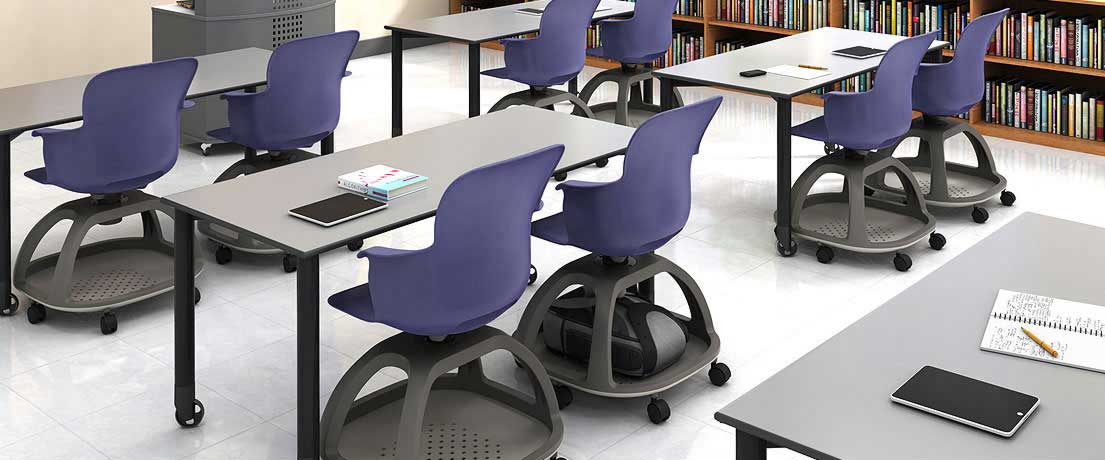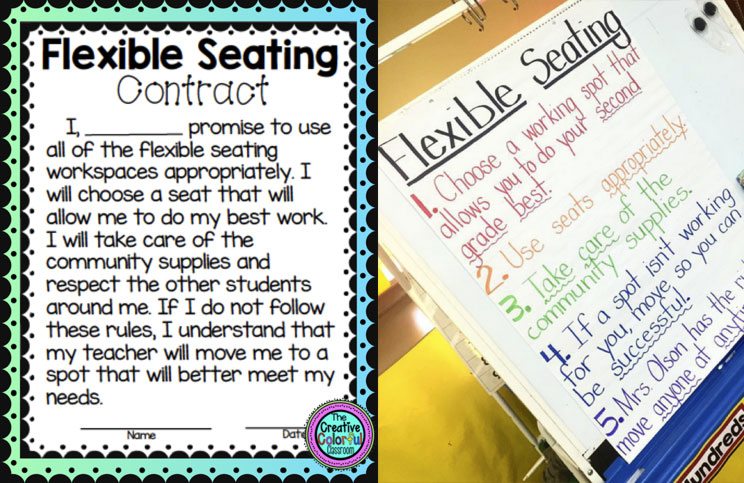“I believed that putting students in rows facing the front of the room would make them easier to manage. I also believed that an effective classroom was a quiet classroom. Everyone was supposed to be quiet except for me.” – Caitlin Tucker, Classroom Furniture: Does it impede or improve learning?
For over a century, classroom design has basically been the same. We can all picture desks lined up in neat rows with a teacher lecturing at the front of the class. However, with technology disrupting education and fundamentally changing the way students learn, there is a movement in the education community towards active classrooms with flexible seating. Many academic studies show the benefits of movement and learning.
However, among the teaching community there are real concerns regarding these new classroom environments. Some common concerns are:
- The students will take control from the teacher
- The teacher will spend too much time managing the classroom and not enough time teaching
- Flexible seating removes much needed structure from learning
- Safety concerns
These are certainly all real concerns for many teachers. They know better than anyone that furniture can have a positive or negative impact on their classrooms. According to eduhealthcare.com’s article Is Flexible Seating Right For Your Classroom?, the answer to that question isn’t always yes. In fact, changing furniture without preparation can cause many of the concerns listed above to come to fruition. The article quotes Lauren Bright, a first-grade teacher at Dishman-McGinnis Elementary School in Bowling Green, KY. “I felt overwhelmed. I felt like I was constantly blowing up exercise ball chairs, and replacing beans in the bean bag chairs. I felt like I had gone through a rather large classroom transformation that was not reaping the benefits I had read about. I know now that I rushed into the seating, and lacked the procedural practice this kind of change desperately needs.”
Are there Really Benefits to Active Learning and Flexible Seating?
In our own Back to School, Movement is Learning blog post, we discuss several studies that credit movement with better learning. A 2013 report from the Institute of Medicine concluded that children who are more active “show greater attention, have faster cognitive processing speed and perform better on standardized academic tests than children who are less active.” And a study released in January by Lund University in Sweden shows that students, especially boys, who had daily physical education, did better in school.” according to the recent NY Times article Why Kids Shouldn’t Sit Still in Class.
The article goes on to share that “John Ratey, an associate professor of psychiatry at Harvard Medical School and the author of Spark: The Revolutionary New Science of Exercise and the Brain, said: “Movement activates all the brain cells kids are using to learn, it wakes up the brain.”
Most educators understand that changes in modern technology have fundamentally shifted their role. Furthermore, research points to the fact that active learning is the best way forward for students. In theory, it all makes sense. But it’s just that—theory. The disconnect seems to be between theory and practice. As Lauren Bright noted, changing the furniture without changing the procedure can create the exact chaotic situation that concerns teachers.
Bridging the Gap from Theory to Practice
“Furniture is still just furniture. That is, replacing desks with pilates balls and sofas won’t accomplish much of anything unless the teacher is prepared for the change.” – Tim Walker, National Education Association, Farewell Desks, Here Come the ‘Starbucks Classrooms’
One thing is clear: the 21st Century Classroom isn’t one size fits all. In fact, the movement towards personalized learning and flexible seating must include personalizing the classroom for the teacher, the students and the subject being taught. Perhaps a science classroom has one designated area with chairs on casters or a sit to stand desk for the teacher. The key is to plan before the purchase. Think about a typical day and what might work best.

It is also important to:
- Consider the teacher, the students and the subject. Think about what’s suitable for the subject being taught and what type of environment would make that teacher most comfortable. A teacher that is uncomfortable in their own classroom can have a negative impact on the students.
- Create rules. Changing classroom furniture doesn’t mean that rules go out the window. Many teachers post rules or make students sign a contract to ensure they understand how to behave in their new space.

Source: http://thecreativecolorfulclassroom.blogspot.com/p/flexible-seating.html
Source: http://luckylittlelearners.com/2016/01/flexible-seating.html
- Go at a comfortable pace. Change doesn’t have to be all or nothing. Administrators can pick specific subjects or teachers for a pilot.
Apprehension about flexible seating and active classrooms is not uncommon. Take it slow and determine what works best for the situation.
“I was apprehensive to allow my active students to use this chair, but it became one of the best things for them. When they were able to swivel in the chair, they were allowed the movement they needed and were not a distraction to the other students.”
-Scott H., GEI Reviewer
“Many teachers shudder at the thought of flexible seating. I did too at one point, but I am here to tell you, if it is done right, it can be a game changer.”
– Amanda, http://www.notsowimpyteacher.com/2017/10/flexible-seating.html
“Raise your hand if you are a teeny, tiny bit controlling ~ if your hand wasn’t raised I don’t believe you. Teachers are by nature a little bit controlling to some degree right?!? Well I’ve released some of the control and they have certainly gained some. But, I’m realizing that with the freedom of choice some of my behaviors that I normally see popping up have tapered down a bit.”
– Vicky, http://www.teachingandmuchmoore.com/2016/08/flexible-seating-its-not-for-everyone.html
Back to Insights










